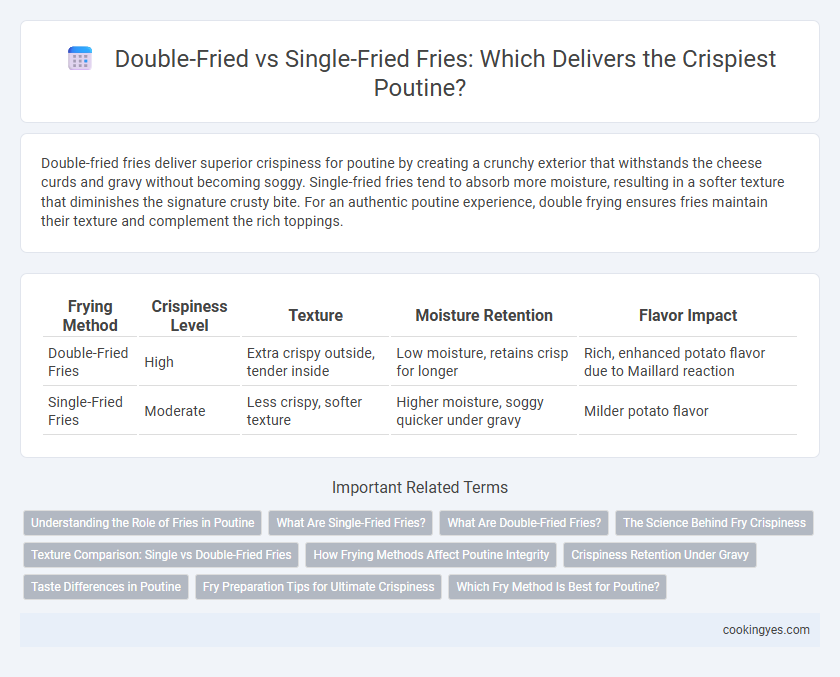Double-fried fries deliver superior crispiness for poutine by creating a crunchy exterior that withstands the cheese curds and gravy without becoming soggy. Single-fried fries tend to absorb more moisture, resulting in a softer texture that diminishes the signature crusty bite. For an authentic poutine experience, double frying ensures fries maintain their texture and complement the rich toppings.
Table of Comparison
| Frying Method | Crispiness Level | Texture | Moisture Retention | Flavor Impact |
|---|---|---|---|---|
| Double-Fried Fries | High | Extra crispy outside, tender inside | Low moisture, retains crisp for longer | Rich, enhanced potato flavor due to Maillard reaction |
| Single-Fried Fries | Moderate | Less crispy, softer texture | Higher moisture, soggy quicker under gravy | Milder potato flavor |
Understanding the Role of Fries in Poutine
Double-fried fries provide a superior crispiness essential for authentic poutine by creating a sturdy outer layer that resists sogginess from the gravy and cheese curds. Single-fried fries tend to absorb moisture quickly, leading to a limp texture that undermines the dish's signature contrast of crunchy and creamy elements. Understanding the role of fries in poutine highlights that maintaining crispness is crucial to balancing textures and enhancing overall flavor satisfaction.
What Are Single-Fried Fries?
Single-fried fries are cooked once at a moderate temperature, resulting in a softer texture and less surface crispiness compared to double-fried fries. This method often yields fries that absorb more gravy and cheese curds when used in poutine, creating a tender bite rather than a crunchy contrast. Double-fried fries, by contrast, undergo an initial frying at lower heat followed by a higher temperature fry, achieving superior crispiness essential for maintaining texture under poutine toppings.
What Are Double-Fried Fries?
Double-fried fries are cooked twice to achieve maximum crispiness, first at a lower temperature to cook the potato through and then at a higher temperature to create a golden, crunchy exterior. This method reduces sogginess, making double-fried fries ideal for poutine, where cheese curds and gravy can otherwise soften the fries quickly. Single-fried fries, cooked only once, often lack the same level of crispness, resulting in a less satisfying texture when combined with rich toppings.
The Science Behind Fry Crispiness
Double-fried fries achieve superior crispiness in poutine due to the Maillard reaction, which intensifies during the second frying stage, creating a thicker, crunchier crust that resists sogginess caused by gravy. Single-fried fries retain more moisture and develop a thinner crust, resulting in a softer texture that quickly absorbs liquid. The science behind fry crispiness highlights dehydration and starch gelatinization during frying, where double frying promotes greater moisture loss and structural reinforcement for optimal poutine texture.
Texture Comparison: Single vs Double-Fried Fries
Double-fried fries achieve superior crispiness compared to single-fried fries due to the initial frying that locks moisture inside and the second frying that creates a crunchy exterior. Single-fried fries tend to be softer and less resilient, often becoming soggy quicker under the weight of gravy and cheese curds in poutine. The double-frying method enhances the texture, ensuring fries retain their crunch and structural integrity when topped, delivering the optimal poutine experience.
How Frying Methods Affect Poutine Integrity
Double-fried fries create a significantly crispier exterior, enhancing poutine's texture by preventing sogginess when smothered in gravy and cheese curds. Single-fried fries tend to absorb more moisture, compromising the structural integrity and resulting in a limp, less satisfying dish. The double-frying method preserves the fries' firmness, maintaining the ideal contrast essential for authentic poutine experience.
Crispiness Retention Under Gravy
Double-fried fries maintain superior crispiness under poutine gravy due to the extra frying step, which removes more moisture and creates a thicker crust. Single-fried fries tend to become soggy quickly as the thinner crust absorbs the gravy faster. The double-frying process enhances fry durability, ensuring a crunchy texture that better withstands the moisture of cheese curds and rich brown gravy in poutine.
Taste Differences in Poutine
Double-fried fries create a crispier exterior and tender interior, enhancing the texture contrast essential for authentic poutine. Single-fried fries tend to be softer and less able to hold up under the weight of gravy and cheese curds, resulting in a less satisfying taste experience. The double-frying method preserves fry crispiness longer, ensuring each bite delivers a balanced combination of crunch and savory flavors.
Fry Preparation Tips for Ultimate Crispiness
Double-fried fries create a superior crispy exterior essential for authentic poutine by first frying at a lower temperature to cook the potatoes through, followed by a higher temperature fry to achieve maximum crunch. Single-fried fries often lack this contrast, resulting in a soggier texture once cheese curds and gravy are added. For ultimate crispiness, ensure fries are cut evenly, dried thoroughly, and fried in small batches to maintain consistent oil temperature.
Which Fry Method Is Best for Poutine?
Double-fried fries create a superior texture for poutine by achieving a crispier exterior and a fluffy interior, essential for holding the cheese curds and gravy without becoming soggy. Single-fried fries often lack durability, leading to a limp finish that diminishes the dish's signature contrast of textures. The double-fry method optimizes moisture removal and surface caramelization, making it the preferred choice for authentic, crispy poutine.
Double-fried fries vs single-fried fries for poutine crispiness Infographic

 cookingyes.com
cookingyes.com